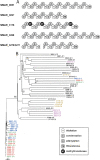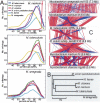Insights from the complete genome sequence of Mycobacterium marinum on the evolution of Mycobacterium tuberculosis
- PMID: 18403782
- PMCID: PMC2336800
- DOI: 10.1101/gr.075069.107
Insights from the complete genome sequence of Mycobacterium marinum on the evolution of Mycobacterium tuberculosis
Abstract
Mycobacterium marinum, a ubiquitous pathogen of fish and amphibia, is a near relative of Mycobacterium tuberculosis, the etiologic agent of tuberculosis in humans. The genome of the M strain of M. marinum comprises a 6,636,827-bp circular chromosome with 5424 CDS, 10 prophages, and a 23-kb mercury-resistance plasmid. Prominent features are the very large number of genes (57) encoding polyketide synthases (PKSs) and nonribosomal peptide synthases (NRPSs) and the most extensive repertoire yet reported of the mycobacteria-restricted PE and PPE proteins, and related-ESX secretion systems. Some of the NRPS genes comprise a novel family and seem to have been acquired horizontally. M. marinum is used widely as a model organism to study M. tuberculosis pathogenesis, and genome comparisons confirmed the close genetic relationship between these two species, as they share 3000 orthologs with an average amino acid identity of 85%. Comparisons with the more distantly related Mycobacterium avium subspecies paratuberculosis and Mycobacterium smegmatis reveal how an ancestral generalist mycobacterium evolved into M. tuberculosis and M. marinum. M. tuberculosis has undergone genome downsizing and extensive lateral gene transfer to become a specialized pathogen of humans and other primates without retaining an environmental niche. M. marinum has maintained a large genome so as to retain the capacity for environmental survival while becoming a broad host range pathogen that produces disease strikingly similar to M. tuberculosis. The work described herein provides a foundation for using M. marinum to better understand the determinants of pathogenesis of tuberculosis.
Figures





References
-
- Abdallah A.M., Verboom T., Hannes F., Safi M., Strong M., Eisenberg D., Musters R.J., Vandenbroucke-Grauls C.M., Appelmelk B.J., Luirink J., Verboom T., Hannes F., Safi M., Strong M., Eisenberg D., Musters R.J., Vandenbroucke-Grauls C.M., Appelmelk B.J., Luirink J., Hannes F., Safi M., Strong M., Eisenberg D., Musters R.J., Vandenbroucke-Grauls C.M., Appelmelk B.J., Luirink J., Safi M., Strong M., Eisenberg D., Musters R.J., Vandenbroucke-Grauls C.M., Appelmelk B.J., Luirink J., Strong M., Eisenberg D., Musters R.J., Vandenbroucke-Grauls C.M., Appelmelk B.J., Luirink J., Eisenberg D., Musters R.J., Vandenbroucke-Grauls C.M., Appelmelk B.J., Luirink J., Musters R.J., Vandenbroucke-Grauls C.M., Appelmelk B.J., Luirink J., Vandenbroucke-Grauls C.M., Appelmelk B.J., Luirink J., Appelmelk B.J., Luirink J., Luirink J., et al. A specific secretion system mediates PPE41 transport in pathogenic mycobacteria. Mol. Microbiol. 2006;62:667–679. - PubMed
-
- Adekambi T., Ben Salah S., Khlif M., Raoult D., Drancourt M., Ben Salah S., Khlif M., Raoult D., Drancourt M., Khlif M., Raoult D., Drancourt M., Raoult D., Drancourt M., Drancourt M. Survival of environmental mycobacteria in Acanthamoeba polyphaga. Appl. Environ. Microbiol. 2006;72:5974–5981. - PMC - PubMed
-
- Alteri C.J., Xicohténcatl-Cortes J., Hess S., Caballero-Olín G., Girón J.A., Friedman R.L., Xicohténcatl-Cortes J., Hess S., Caballero-Olín G., Girón J.A., Friedman R.L., Hess S., Caballero-Olín G., Girón J.A., Friedman R.L., Caballero-Olín G., Girón J.A., Friedman R.L., Girón J.A., Friedman R.L., Friedman R.L. Mycobacterium tuberculosis produces pili during human infection. Proc. Natl. Acad. Sci. 2007;104:5145–5150. - PMC - PubMed
-
- Altschul S.F., Gish W., Miller W., Myers E.W., Lipman D.J., Gish W., Miller W., Myers E.W., Lipman D.J., Miller W., Myers E.W., Lipman D.J., Myers E.W., Lipman D.J., Lipman D.J. Basic local alignment search tool. J. Mol. Biol. 1990;215:403–410. - PubMed
-
- Aronson J.D. Spontaneous tuberculosis in salt water fish. J. Infect. Dis. 1927;39:315–320.
Publication types
MeSH terms
Substances
Associated data
- Actions
- Actions
Grants and funding
LinkOut - more resources
Full Text Sources
Other Literature Sources
Molecular Biology Databases
